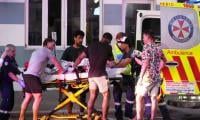Continuing his efforts to draw attention to the different aspects of the glorious past and the chaotic present of the sprawling metropolis, academic and journalist Akhtar Balouch in the third edition of his ‘Karanchi Wala’ has touched on different subjects related to the city.
Similar to his previous books, the recent volume, titled ‘Karanchi Wala 3’, discusses some aspects about the history of Karachi and the remnants of its cosmopolitan culture, using references of rarely available publications, researches, and interviews.
The new volume contains 30 pieces touching on different subjects related to the city. They vary from buildings and parks to personalities and communities.
In the book’s preface, noted journalist Wusatullah Khan appreciated Balouch’s work. He writes that write-ups of Balouch, Pir Muhammad Ali Rashidi, Usman Damohi and Gul Hasan Kalmati about Karachi and its history reconnect the city’s residents with its glorious past.
The topics of some of the pieces in the book include the demystification of the date of Independence Day, Nishtar Park, Napier Road, old books, ‘India in Karachi’, the city’s old Eidgahs, and the fascinating hobbies of Maharajas and Nawabs.
Balouch says his main objective of writing about Karachi is to make the residents aware of the massive contributions of different communities, personalities, historical buildings and parks in developing the city, as well as philanthropic activities, entrepreneurship, education, art, and music.“Karachi’s residents owe them a lot,” Balouch says while talking to The News.
Vanishing Iranian restaurants
Balouch in an essay discusses the history of setting up Iranian restaurants in the city. He says most of these restaurants were founded by Zoroastrians and Baha’is – some of the earliest communities to migrate to Karachi. He also attempts to know why all Iranian restaurants are located at street corners.
Farsheed Rohani, the owner of the Café Eros, an Iranian restaurant that was opened in 1947 and closed down in 2015, told Balouch that because of the worst economic situation in Iran during the 1910s, a large number of people from Iran migrated to Bombai and Karachi. “Among them, Bomin Abadan, a Parsi, opened the first restaurant in Saddar neighbourhood in 1912 or 1913 and after getting inspiration from the success of his business, people from Iran started migrating to Karachi to open restaurants in the city,” Rohani was quoted as saying.
Citing some references, Balouch said most of the Baha'is who migrated to Karachi fled religious persecution in Iran in the early 1900s. Seth Jahangir, an Iranian trader, had helped most of the Iranian migrants to start their business in the city, he writes.
Karachi’s first elected mayor
In an essay on Karachi’s first elected mayor Jamshed Nusserwanjee (1886-1952), who was also from the Parsi community, Balouch discusses his work as the city’s first elected mayor, a philanthropist and an architect whose developmental contributions earned him the title of ‘Maker of Modern Karachi’. Last month, he was being fondly remembered on his 134th birth anniversary celebrations in Karachi.
Citing the work of historian Gul Hasan Kalmati, Balouch writes that Nusserwanjee came to prominence after serving the residents of Karachi after an outbreak of Influenza infection in 1919. In 1922, he was elected president of the Karachi Municipality, an office which he occupied till October 1932.
G. M. Syed, a prominent Sindhi nationalist leader, in his book Guzaaryam Jann Seen (Those Who I Spent My Lifetime With), writes that Nusserwanjee played a key role in the movement of separating Sindh from the Bombay Residency. Although he understood that in a separate Sindh he would have to rely on Hindu voters for his political career, he did not worry about that.
Polo Ground
Polo Ground, now known as Bagh-e-Quaid-e-Azam, adjacent to the Sindh Governor House, was actually part of the Hindu Gymkhana. After the partition, as the Hindu Gymkhana was no longer reserved for Hindus, the Polo Ground, too, slipped out of their hands.
He also cites Aqeel Abbas Jafri, a researcher, who said that after the Partition, when Karachi became the capital of the newly formed Pakistan, the independence military parade would always be held at the Polo Ground.
According to Jafri, weapons seized from the Indian army personnel during the 1965 Indo-Pak war were also put on display in this ground. The exhibition included an enemy tank that had the name Fakhr-e-Hindustan (Pride of India) written on it.
Ranchor Line
In an essay, Ranchor Line – which has been renamed to Gizdar Abad and is one of oldest settlements in Old City area where most of the inhabitants are from the Salawat community who migrated from Rajasthan – Balouch writes various charms of the area, such as wooden benches on almost every corner of every street, varies of salons, from the most elegant hairdressers to the traditional hajjam (barber) with a chair and a mirror hanging in front, and food joints that do not serve any item that has red chilli in it.
Temple for Geeta
Balouch has also informed his readers about a Hindu temple in Mithadar which has been set up by a Muslim family in their house and only a girl worshipped at this temple, all other members being Muslims.
Leading Pakistani philanthropist Bilquis Edhi had set up the temple for Geeta, the deaf and mute woman, who returned to India 2015 after being stranded in Pakistan for 13 years. Edhi, a trustee of the charity, told Balouch that when Geeta came to them, it was clear from her actions that she was Hindu. “So I had a temple built on the third floor of the charity’s building in Mithadar,” she said.















